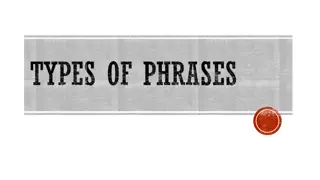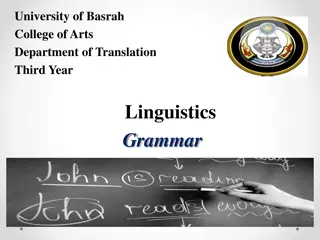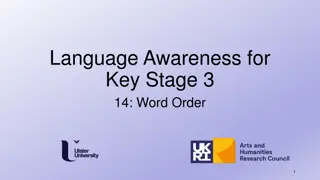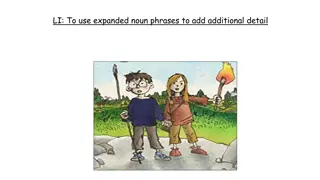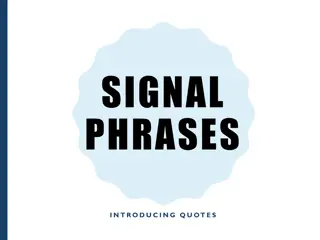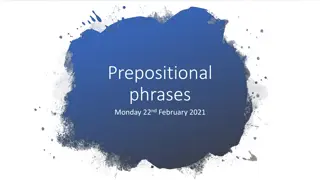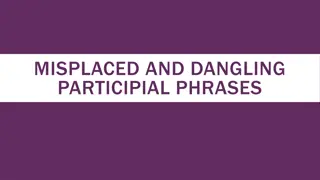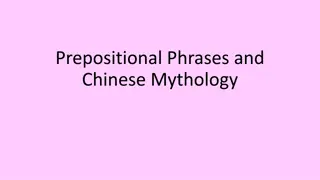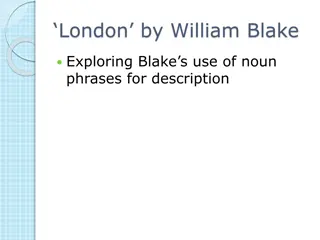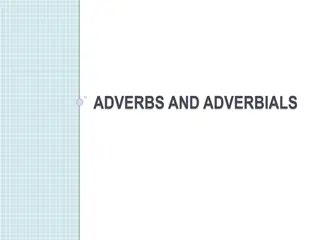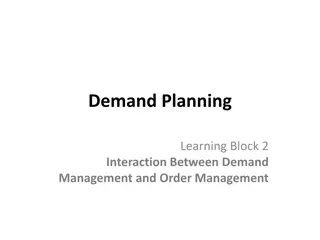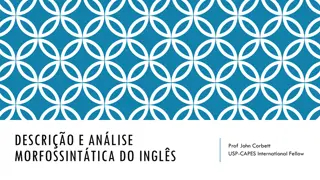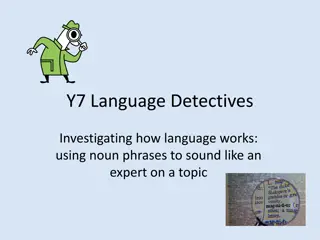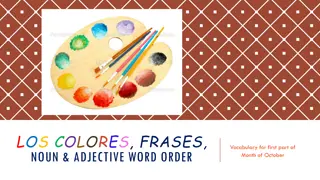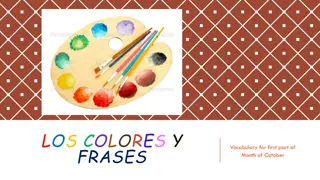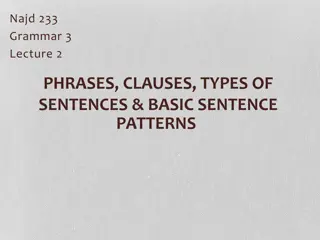Word order and phrases in a network
My aim is to model language as general cognition, treating it not as a separate module of the mind but as part of general cognitive processes. Language is viewed as a network, with taxonomies allowing inheritance and link types being invented as needed to distinguish grammatical functions. The study explores word order phenomena, ad hoc link creation, coordination, and the relationship between language and general cognition. Linguistic descriptions rely on formal apparatus outside language, without the need for special linguistic mechanisms like PS rules or transformations. General cognition is depicted as a network of concepts with classified relations that manifest in neuronal activation and priming effects. The study also discusses Isa and inheritance, taxonomies, and partonomies in the context of language modeling.
Download Presentation

Please find below an Image/Link to download the presentation.
The content on the website is provided AS IS for your information and personal use only. It may not be sold, licensed, or shared on other websites without obtaining consent from the author.If you encounter any issues during the download, it is possible that the publisher has removed the file from their server.
You are allowed to download the files provided on this website for personal or commercial use, subject to the condition that they are used lawfully. All files are the property of their respective owners.
The content on the website is provided AS IS for your information and personal use only. It may not be sold, licensed, or shared on other websites without obtaining consent from the author.
E N D
Presentation Transcript
Word order and phrases in a network Dick Hudson Humboldt University Berlin, January 2019 1
Summary 1. My aim is to model language as general cognition. 2. Language is a network. 1. Taxonomies allow inheritance, but partonomies don t. 2. Link types can be invented as needed, e.g. word-word dependencies. 3. Link types are classified so we distinguish grammatical functions. 4. Types, tokens and sub-tokens form a taxonomy. 3. So what? (1) 4. Word order, including raising, lowering and long-distance extraction. 5. More on the free creation of ad hoc links, including phrase boundaries. 6. Coordination. 7. So what? (2) 1. and a final fact 2
1. Language as general cognition Is language unique? I.e. is language a special module of the mind? Or is it just like the rest of cognition? How to find out? Assume it s like the rest of cognition, and describe it in those terms. Failure It s a special module. Success It s not. Word Grammar (my theory) makes this assumption. The answer so far? Success. 3
So Linguistic descriptions use only formal apparatus found outside language. No special apparatus such as PS rules, transformations, optimality grids Linguistic descriptions have access to all the formal apparatus found outside language. Every general-purpose device comes for free. We don t need to limit the devices used. There s no pressure for elegance or parsimony. E.g. we can create new relations freely. 4
2. The network notion of cognition arm General cognition is a network of concepts with relations that are classified which are mental and symbolic but which are implemented in neurons which carry activation which spills over onto network neighbours which causes priming: e.g. doctor primes nurse = makes the word and its meaning more active. part upper arm fore- arm hand joiner joiner elbow wrist doctor colleague nurse 5
2.1 Isa and inheritance Has two legs bird General cognition allows generalisations e.g. if it s a bird, it has two legs In other words, examples are linked to general types (by isa ) examples inherit properties across isa links. So the network is an inheritance network containing isa links other links isa Has two legs example 6
Taxonomies and partonomies Isa relations define a taxonomy, or classification. Part-whole relations define a partonomy (= meronomy). This difference is important: Taxonomies are based on similarity. Partonomies are based on size and containment. The difference is fundamental in syntax! Has four fingers Has four fingers 7 a taxonomy a partonomy
Taxonomies and partonomies in syntax Beware of unclassified links in tree diagrams! Part-whole relations are logically different from isa relations. NP Partonomy part part Det Noun Taxonomy man the 8
Default inheritance and exceptions token The logic is default inheritance. A (typical) bird flies. A sparrow isa bird, so it flies. A penguin isa bird. But a penguin doesn t fly. Some people object that default inheritance is non- monotonic. An earlier inference may be overridden by a later one. But in Word Grammar, default inheritance is monotonic because it s part of node-creation which creates and enriches token nodes. 1 0 flying flying penguin sparrow flying bird 1 9
2.2 Free linkage concept In general cognition, anything can link to anything else. Cognition reflects experience. And relation-types can be created as needed. e.g. joiner , part , colleague . Relations are a kind of concept and form a taxonomy. entity relation colleague part centre boss 10
Free linkage in syntax Presumably free linkage also applies to syntax subject to functional constraints. Then words can link directly to each other. This is dependency analysis. But PS denies this, and only recognises part-whole relations. Why deny word-word links? in We Berlin. are 11
Leonard Bloomfield (1887-1949) 1913-14 he visited Leipzig where Wilhelm Wundt (1832-1920) had created the first laboratory of experimental psychology with 184 PhD students! Ein redlich denkender Mensch verschm ht die T uschung Wundt also wrote about syntax proposition = subject + predicate propositions all the way down Bloomfield followed Wundt ... A1 = ein Mensch B1 = denkt redlich G = Gesamtvorstellung A = subject B= predicate edlich denkender Mensch verschm ht die T uschung A3 = der Gedanke B3= ist redlich vers 12 dlich denkender Mensch verschm ht die
and not Franz Kern 1830-1894, in ... and Berlin Gymnasialdirektor (K lnisches Gymnasium) and philologist Grundriss der Deutschen Satzlehre 1884 The first pure dependency grammar except Brassai 1873 and Dmitrievskij 1877 His stemma is not a partonomy. 13
2.3 Classified links and grammatical functions dependent We can, and do, classify relations in general cognition. So why not in syntax? Why not recognise grammatical functions? Dependency types are concepts so they form a taxonomy. valent adjunct subject comple- ment predic- ative in We Berlin. are 14
2.4. Types and tokens Types are permanent, in long-term memory. Tokens are temporary and in working memory. Each token is unique. Types and tokens are connected by isa. So tokens are also part of the cognitive network of concepts. BOY BOY: plural Some big boys came in. All the boys were ... boys1 boys2 15
Tokens and sub-tokens outside language bird plane flying saucer Token = example/exemplar. One token may be represented by a series of sub-concepts, reflecting mental changes and linked by isa . General principle: different properties different concepts. concept 3 concept 1 concept 2 16
Sub-tokens in unary branching _ V Det _ man the man Classification shows similarities. NPs can be subjects (etc) can contain Det Ns can follow Det can be inside NP But bare Ns are both so use unary branching but this requires separate tokens of one word. [Det + N] NP [N]NP _ V Det _ men men [Det + N] NP [N]NP NP men1 men2 N 17
past tense past tense Sub-tokens in processing time1 e t3e t4e t2 t5e t6e t7 We create new sub-tokens when we correct an error. E.g. in garden-path sentences. But maybe we do the same each time we modify a word. Tesni re thought so too. But the sub-tokens form a taxonomy, not a partonomy. The horse raced past the barn fell t7 raced1 t1 metwe t4 passive metyesterday t3 metthere t1 t4 t3 t2 We met there yesterday 18
3. So what? (1) Dependencies between words are psychologically plausible contrary to Chomsky s PSG. They are relations, so they form a taxonomy of grammatical functions contrary to most versions of HPSG. But we do recognise a sub-token of the head for every dependent: same number of nodes as in Bare PSG but in a taxonomy, not a partonomy! hate British Brexit. linguists subject object adjunct hatelinguists linguistsBritish hateBrexit Brexit. British linguists hate 19
4. Word order As in general cognition, a network has no left-right dimension, so position is defined in terms of landmarks. expected position follows from more abstract relations. but it may follow a chain of relations. Likewise in syntax. cellar land- mark land- mark owner Brexit. British linguists hate lm lm lm 20
Positions More precisely, X s position is defined by: X s position P X s landmark s position L a relation between P and L This allows positions to be treated as properties and overridden by default inheritance. Brexit. British linguists hate pos lm lm lm < < > 21
Raising Itraining lm s p < In It is raining, it is the subject of both is and raining. So why is raining irrelevant to its position? Raining it is. Is it raining? Because each subject link defines a different sub-token of it: itisand itraining each with its positional properties and itisisa itraining so by default inheritance, the position of itis overrides the position of itraining. This is the default for structure sharing. s s pr It Itis is raining. lm p < s s pr raiser 22
But lowering is also possible E.g. in German Partial VP fronting: Eine Concorde gelandet ist hier nie. Lowering is exceptional but allowed by default inheritance. Eine Concordeist Eine Concordegelandet gelandet ist hier nie. 23
Long-distance dependencies in extraction We need a new dependency: extractee ( x ) plus structure sharing as in raising. Whatwant x+o Whatthat x Whatsay x Whatshould x Whatthink x x What do you think we should say that we want _? 24
5. Free creation of links Even if we have dependencies, we can have other kinds of link in syntax as well. E.g. in pied-piping we have a pipee . which house we in live pipee 25
Definitely NOT head of the phrase! Phrase boundaries Similarly, phrase boundaries are important in some languages e.g. Welsh, where llawn > lawn by soft mutation at the start of a phrase: Dw i [lawn mor grac chi]. be.PRES.1S I full as angry as you I m just as angry as you. We can freely invent a relation start . especially since this relation already exists in ordinary cognition. start Dw i lawn mor grac chi s c c a a 26 c
6. Coordination Here the crucial notion is set . This is freely available in general cognition. A relation can apply to a set. But: What is the status of and? And: What about incomplete conjuncts? I read books about [linguistics on weekdays] and [astronomy at weekends]. Bill and Ann bought and ate apples and oranges. 27
So what? (2) Dependency structure is available for free, so why not use it? It allows analyses of complex structures without going beyond the apparatus of general cognition. But it s not enough in itself. We also need: sub-tokens creating multiple nodes per head word. positions and landmarks. (in some languages) phrase boundaries (but not phrase nodes). sets for coordination. occasional extra relations such as pipee . More generally, ... 28
Between PS and DS? Word Grammar is between PS and DS. Like DS, no units longer than words. Like PS, a separate head node for each dependency. But dominance is logical isa, not part-whole. I love grammar loveI s love grammar lovegrammar o grammar I love grammar grammar I I love love 29
t1 Between competence and performance? metwe t4 performance metyesterday Performance is the temporary network created for an utterance in real time. Competence is the permanent network of lexico-grammar. But they re part of the same network. And arguably competence is just performance that s been made permanent. t3 metthere t4 t1 t3 t2 We met there yesterday /met/ meet past competence verb 30
Not a word (till recently) .... Between language and thought? Language uses the apparatus of ordinary thinking and nothing else. So language is part of thinking. And language really is a window into the human mind . Words don t just express concepts. They are concepts. So they can combine with non-language. word went The train !!! 31
Thank you for listening These slides can be downloaded from dickhudson.com/talks I m very happy to discuss them at r.hudson@ucl.ac.uk. 32



